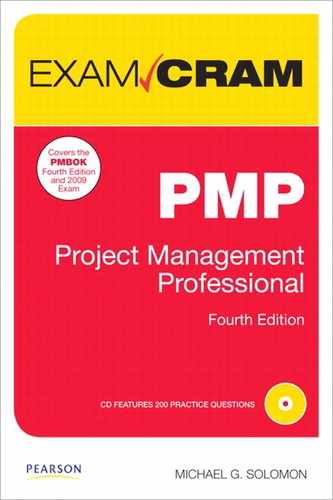Chapter 4
Explore More Elements of Project Planning
The main components of the project management plan are the primary drivers that establish key project baselines (scope, schedule, and cost). Additional planning processes are equally important and establish the mechanisms to apply quality, stakeholder assignment, project information management (communication), reality (risk), and procurement assignment to those baselines. These plans include items such as the following:
![]() Quality management plan—This plan describes how the team will implement the quality policy. It addresses quality control, quality assurance, and continuous improvement.
Quality management plan—This plan describes how the team will implement the quality policy. It addresses quality control, quality assurance, and continuous improvement.
![]() Human Resources management plan—Describes when and how Human Resource requirements will be met, including acquisition approach, timing, training, and recognition.
Human Resources management plan—Describes when and how Human Resource requirements will be met, including acquisition approach, timing, training, and recognition.
![]() Communication management plan—Describes how communication requirements will be met, including stakeholder communication, communication responsibility, communication timing, and techniques.
Communication management plan—Describes how communication requirements will be met, including stakeholder communication, communication responsibility, communication timing, and techniques.
![]() Risk management plan—This plan describes how risk management activities will be performed, including methodology, responsibility, cost, timing, and definitions for risk categories, probabilities, and impacts.
Risk management plan—This plan describes how risk management activities will be performed, including methodology, responsibility, cost, timing, and definitions for risk categories, probabilities, and impacts.
![]() Procurement management plan—This plan describes how procurement activities will be performed, including contract types and responsibilities.
Procurement management plan—This plan describes how procurement activities will be performed, including contract types and responsibilities.
Quality Management
![]() Plan Quality—8.1
Plan Quality—8.1
Although the project manager has overall responsibility for quality, the entire project team plays a role in quality management. Every member of the project team must understand the importance of contributions, accept ownership for problems, be committed to monitoring and improving performance, and be willing to openly discuss issues among team members.
Although specific techniques and measures apply to the product being produced, the overall project quality management approach applies to any project and is relevant to the project as well as the product being produced.
The terms quality and grade are often confused. They are separate concepts and the PMBOK clearly notes their differences. Table 4.1 compares low and high values of quality and grade.

The plan quality process has a number of key inputs, many of which originate from other initiating and planning processes. Table 4.2 shows the inputs, tools and techniques, and outputs for the plan quality process.
TABLE 4.2 Plan Quality Inputs, Tools and Techniques, and Outputs
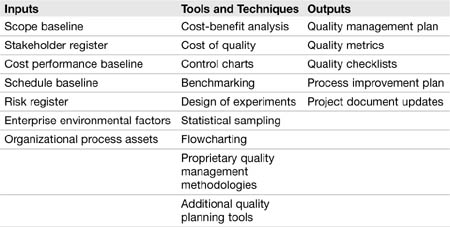
The plan quality process incorporates various quality concepts with which you should be familiar. The following list highlights important key concepts in PMI’s quality management:
![]() The cost of preventing mistakes is generally less than the cost of repairing them.
The cost of preventing mistakes is generally less than the cost of repairing them.
![]() In order to be successful, management support for the quality program must exist.
In order to be successful, management support for the quality program must exist.
![]() Quality is tied closely to the scope-cost-time constraints; without quality these objectives cannot be met successfully.
Quality is tied closely to the scope-cost-time constraints; without quality these objectives cannot be met successfully.
![]() The cost of quality refers to the cost to implement a quality program.
The cost of quality refers to the cost to implement a quality program.
![]() Understanding and managing customer expectations is important to a successful quality program.
Understanding and managing customer expectations is important to a successful quality program.
![]() The quality program should emphasize continuous improvement.
The quality program should emphasize continuous improvement.
![]() There is a close alignment between the quality approach and the overall project management approach on a project.
There is a close alignment between the quality approach and the overall project management approach on a project.
Quality Theories and PMI Quality Management Approach
The quality management approach presented in the PMBOK is intended to be compatible with other standards, including the International Organization for Standardization (ISO), Total Quality Management (TQM), Six Sigma, and others.
Exam questions on this topic are frequently taken from sources other than the PMBOK. Table 4.3 identifies some of the more popular quality theories.
TABLE 4.3 Common Quality Theories

The Plan-Do-Check-Act (PDCA) Cycle
PMI identifies the Plan-Do-Check-Act (PDCA) cycle, also referred to as the Deming Cycle, as both a quality tool and the underlying concept for interaction among project management processes. First, an improvement is planned. Next, the improvement is carried out and measured. The results are checked and finally acted upon. Acting upon the improvement might mean making the improvement a standard, further modification to the improvement, or abandoning the improvement. Figure 4.1 demonstrates the PDCA cycle.
FIGURE 4.1 The Plan-Do-Check-Act cycle.
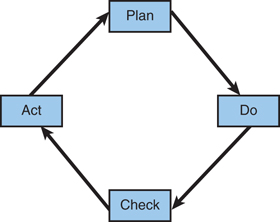
Quality Approaches and Project Management
Quality approaches align with project management approaches in a number of areas, including achieving customer satisfaction, preventing defects instead of inspecting for them, management support for quality, and continuous improvement. Table 4.4 provides additional detail.
TABLE 4.4 Principles Common to Quality Management and Project Management

The Cost of Quality
The cost of quality (COQ) is a term that refers to the cost to produce a product or service that meets requirements. Part of the cost is rework when requirements aren’t met. An effective quality program reduces cost from rework.
The three primary types of cost associated with the cost of quality are
![]() Prevention costs
Prevention costs
![]() Inspection costs
Inspection costs
![]() Failure costs (internal and external)
Failure costs (internal and external)
Addressing prevention and inspection can be viewed as addressing the cost of conformance. This includes training, prototyping, design reviews, and testing. Failure costs (the cost of nonconformance) includes bug fixes, rework, cost of late delivery, and customer complaints.
Differences Among Quality Planning, Quality Assurance, Quality Control
One area of confusion, especially among project managers without a background in quality, is the difference between the three processes in quality management. Table 4.5 helps clarify these concepts.
TABLE 4.5 Summary of Quality Management Processes
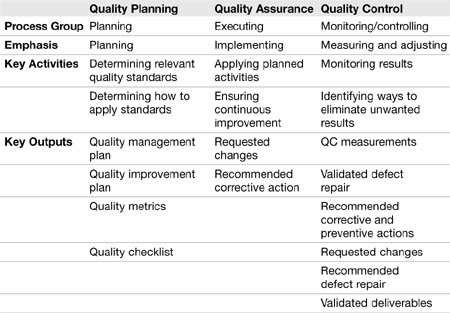
Control Charts and Other Tools
You’ll see the term control chart mentioned in several areas of the PMBOK. A control chart is simply a graph that depicts upper and lower control limits, upper and lower specification limits, and actual performance data collected from project activities. Upper and lower specification limits correspond to the requirements from the project contract. The upper and lower control limits are placed at points at which action must be taken to avoid exceeding the specification limits. If performance data exceeds the upper control limit the project manager can implement appropriate changes to bring the quality back in line before the upper specification limit is exceeded and the project is in violation of the contract. The graph makes it easy to see when actual performance exceeds the predefined upper or lower limits. Figure 4.2 shows an example of a control chart.
FIGURE 4.2 Sample Control Chart.
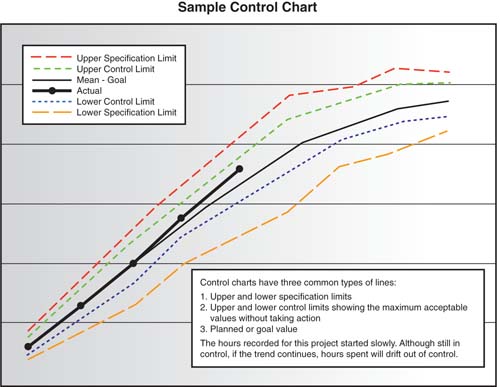
Control charts are not the only tools at your disposal. As a project manager you also have access to quality planning tools such as
![]() Brainstorming—Generally an open forum that includes knowledgeable people in appropriate disciplines and encourages free expression of ideas.
Brainstorming—Generally an open forum that includes knowledgeable people in appropriate disciplines and encourages free expression of ideas.
![]() Affinity diagrams—Diagram to help identify logical groupings based on similar attributes.
Affinity diagrams—Diagram to help identify logical groupings based on similar attributes.
![]() Force field analysis—Visual depictions of forces that favor and oppose change.
Force field analysis—Visual depictions of forces that favor and oppose change.
![]() Nominal group techniques—Small brainstorming groups where output is reviewed by a larger group.
Nominal group techniques—Small brainstorming groups where output is reviewed by a larger group.
![]() Matrix diagrams—Multiple groups of information presented to show relationships between factors, causes, and objectives. Each intersection of a row and column describes a relationship between items placed in the row and in the column.
Matrix diagrams—Multiple groups of information presented to show relationships between factors, causes, and objectives. Each intersection of a row and column describes a relationship between items placed in the row and in the column.
![]() Prioritization matrices—Provides a method of ranking sets of problems by importance.
Prioritization matrices—Provides a method of ranking sets of problems by importance.
Cram Quiz
Answer these questions. The answers follow the last question. If you cannot answer these questions correctly, consider reading this section again until you can.
1. Which of the following is not a responsibility of the project manager?
![]() A. Acquiring HR resources for the project team
A. Acquiring HR resources for the project team
![]() B. Managing overall responsibility for quality in the organization
B. Managing overall responsibility for quality in the organization
![]() C. Overall responsibility for risk on the project
C. Overall responsibility for risk on the project
![]() D. Overall responsibility for customer satisfaction on the project
D. Overall responsibility for customer satisfaction on the project
2. Which subsidiary plan/component documents how the organization will achieve the quality objectives for the project?
![]() A. Quality management plan
A. Quality management plan
![]() B. Quality baseline
B. Quality baseline
![]() C. Process improvement plan
C. Process improvement plan
![]() D. Quality control checklist
D. Quality control checklist
3. Which quality theory outlines 14 points and calls for quality awareness at all levels of the organization?
![]() A. CMM
A. CMM
![]() B. Kaizen
B. Kaizen
![]() C. TQM
C. TQM
![]() D. Malcolm Baldrige
D. Malcolm Baldrige
Cram Quiz Answers
1. Answer B is correct. Senior management is responsible for quality in the organization. The project manager is responsible for product quality on the project.
2. Answer A is correct. The quality management plan lists which quality policies apply to the project and documents how the quality objectives will be met. The quality baseline documents the quality objectives for the project. The process improvement plan documents how processes will be analyzed for improvement. A quality control checklist is used to ensure steps of a process are completed.
3. Answer C is correct. Total Quality Management (TQM) uses 14 points and calls for quality awareness from everyone involved. CMM outlines five levels of process maturity. Kaizen, or continuous improvement, calls for a cycle of improvements to processes. Malcolm Baldrige is an award for quality awareness.
Human Resource Management
![]() Develop Human Resource Plan—9.1
Develop Human Resource Plan—9.1
The project manager must fulfill the role of manager and leader of the project team. Using the same skills and techniques a line manager uses, the project manager has the following responsibilities:
![]() Determine the HR needs of the project
Determine the HR needs of the project
![]() Negotiate with line managers for internal resources
Negotiate with line managers for internal resources
![]() Acquire external resources through the procurement process
Acquire external resources through the procurement process
![]() Determine training needs
Determine training needs
![]() Identify/plan team-building activities
Identify/plan team-building activities
![]() Determine the performance review approach for a project’s human resources
Determine the performance review approach for a project’s human resources
![]() Determine the reward and recognition approach for motivational purposes
Determine the reward and recognition approach for motivational purposes
![]() Document the team structure and each team’s responsibilities
Document the team structure and each team’s responsibilities
![]() Create a project organization chart
Create a project organization chart
![]() Develop a staffing management plan
Develop a staffing management plan
Key Human Resource Principles
Human resource management is the set of processes used to organize and manage the project team, also referred to as the project staff. A subset of the project team is the project management team, composed of the project manager, project sponsor, and others responsible for project management activities such as planning, controlling, and closing the project.
Project human resource management is composed of human resource planning, acquiring, developing, and managing the team. HR planning has a number of key deliverables, including project organization charts, the staffing management plan, and determining the roles and responsibilities of each human resource. Table 4.6 shows the inputs, tools and techniques, and outputs for the develop human resource plan process.
TABLE 4.6 Develop Human Resource Plan Inputs, Tools and Techniques, and Outputs

It is important to understand the various methods organizations use to depict and describe human resources and their attributes. Table 4.7 summarizes the tools used in human resource planning.
TABLE 4.7 Human Resource Planning Tools

In addition to graphical representations, resources might be documented in matrix-based documents such as a responsibility assignment (RACI) matrix. These documents are effective communication tools to ensure team members understand for which assignments they are responsible. Table 4.8 shows an example of an RACI matrix.

The Staffing Management Plan
The staffing management plan is used to document the type of resources needed and the timing for those resources. The plan includes how the resources will be acquired, start and end dates, training requirements, policies and procedures for the team, and the team recognition approach and budget.
Cram Quiz
Answer these questions. The answers follow the last question. If you cannot answer these questions correctly, consider reading this section again until you can.
1. Which resource planning tool provides information on resource responsibility and accountability?
![]() A. OBS
A. OBS
![]() B. Resource breakdown structure
B. Resource breakdown structure
![]() C. RAM
C. RAM
![]() D. RACI matrix
D. RACI matrix
2. What is the primary purpose of the human resource plan?
![]() A. Identify and document roles, responsibilities, and skills necessary for project goal fulfillment
A. Identify and document roles, responsibilities, and skills necessary for project goal fulfillment
![]() B. Describe how the project team will interact
B. Describe how the project team will interact
![]() C. Assemble the project team
C. Assemble the project team
![]() D. Document strategies to motivate the project team
D. Document strategies to motivate the project team
Cram Quiz Answers
1. Answer C is correct. The RACI (responsible, accountable, consulted, informed) matrix provides information both on resource responsibility and accountability. The RAM only provides responsibility information. Neither the OBS nor resource breakdown structure provide responsibility information.
2. Answer A is correct. Answers B, C, and D describe other processes in the executing process group.
Communications Management
![]() Plan Communications—10.2
Plan Communications—10.2
Projects require the coordinated efforts of multiple team members. The success of the project is at least partially dependent on the quality of communication between team members. The communication plan addresses the necessary elements of team communication and leaves little room for assumptions. This plan is important to set the expectations of how the project team should communicate in an effective and timely manner. It also sets the expectations of the stakeholders and makes their need for information a part of the overall project plan. Most communication issues start with a lack of clear directives as to how and when to communicate. Further, most people are reluctant to initiate unsolicited communication. The communication plan is crucial to good project team interaction. The plan actually tells team members what is expected of them throughout the project. Table 4.9 shows the inputs, tools and techniques, and outputs for the plan communications process.
TABLE 4.9 Plan Communications Inputs, Tools and Techniques, and Outputs
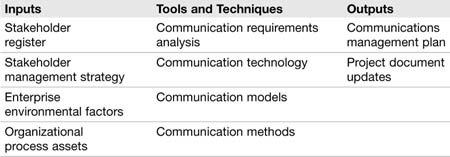
Cram Quiz
Answer these questions. The answers follow the last question. If you cannot answer these questions correctly, consider reading this section again until you can.
1. What type of communication would be best for casual, non-urgent information exchange between team members in geographically distant locations?
![]() A. Telephone
A. Telephone
![]() B. Conference call
B. Conference call
![]() C. Email
C. Email
![]() D. Shared memo
D. Shared memo
2. Which type of communication would be the best choice for discussing schedule changes to an entire team that is located in several different physical sites?
![]() A. Conference call
A. Conference call
![]() B. Email
B. Email
![]() C. Website
C. Website
![]() D. One-on-one telephone calls
D. One-on-one telephone calls
Cram Quiz Answers
1. Answer C is correct. Email provides a good medium for exchanging messages among team members who are in different time zones. Telephone conversations and conference calls require much more scheduling effort and shared memos require additional effort to exchange.
2. Answer A is correct. In this case, a conference call provides the ability for the project manager to inform the team simultaneously and also take feedback from team members. The other options are more time consuming and make feedback more difficult.
Risk Management
![]() Plan Risk Management—11.1
Plan Risk Management—11.1
![]() Identify Risks—11.2
Identify Risks—11.2
![]() Perform Qualitative Risk Analysis—11.3
Perform Qualitative Risk Analysis—11.3
![]() Perform Quantitative Risk Analysis—11.4
Perform Quantitative Risk Analysis—11.4
![]() Plan Risk Responses—11.5
Plan Risk Responses—11.5
PMI’s risk management philosophy is based on a proactive approach to preventing negative risks and enhancing positive risks. Key points to remember about risk include
![]() Risk can be either positive or negative. Positive risks are opportunities; negative risks are threats.
Risk can be either positive or negative. Positive risks are opportunities; negative risks are threats.
![]() A risk breakdown structure (RBS) is used to organize risk in a hierarchical structure.
A risk breakdown structure (RBS) is used to organize risk in a hierarchical structure.
![]() Monte Carlo analysis is a technique using simulations and probability in determining quantitative risk analysis.
Monte Carlo analysis is a technique using simulations and probability in determining quantitative risk analysis.
![]() Risk categories are important in classifying risk.
Risk categories are important in classifying risk.
![]() Probability and impact are both needed to assess risks.
Probability and impact are both needed to assess risks.
![]() Quantitative analysis is generally reserved for high-probability, high-impact risk.
Quantitative analysis is generally reserved for high-probability, high-impact risk.
![]() Risk management planning and risk response planning are not the same activities.
Risk management planning and risk response planning are not the same activities.
![]() Risk identification is an iterative process that is performed throughout the project, not just during planning.
Risk identification is an iterative process that is performed throughout the project, not just during planning.
![]() Decision tree analysis is a technique using probabilities and costs for structured decision making.
Decision tree analysis is a technique using probabilities and costs for structured decision making.
![]() Five of the six risk management processes are conducted during the planning process group.
Five of the six risk management processes are conducted during the planning process group.
![]() The risk register is an important tool for capturing and tracking risks.
The risk register is an important tool for capturing and tracking risks.
The risk methodology is a definition of how risk will be managed. It includes the approach, tools, and techniques to be used for the project. The approach details how the steps of the risk process will be conducted. For example, the approach could specify that risk analysis will be conducted at the end of each planning meeting. The tools can include the risk register, the risk breakdown structure, the probability and impact matrix, and checklists.
Risk Management Planning and Risk Response Planning
The risk management plan includes the risk methodology, roles/responsibilities, budget, execution timing, and definitions for risk categories, probabilities, and impacts. It is a summation of how the project team will carry out the remainder of the risk management activities for the project. The risk management plan should not be confused with the risk response plan, which is where the project manager captures responses to specific risks that have been identified during the risk identification process.
The risk management plan is the single output of the plan risk management process. Table 4.10 shows the inputs, tools and techniques, and outputs for the plan risk management process.
TABLE 4.10 Plan Risk Management Inputs, Tools and Techniques, and Outputs

Risk Breakdown Structure (RBS)
A risk breakdown structure (RBS) is a tool that can be used to organize risks in a hierarchical fashion. The structure is defined using the risk categories. Even if an RBS is not used, risk categories are still defined in risk management planning. Risk categories can include
![]() Technical—Risk associated with using new technology.
Technical—Risk associated with using new technology.
![]() External—Risk associated with forces or entities outside the project organization. External risks can include external suppliers, customers, weather, and market conditions.
External—Risk associated with forces or entities outside the project organization. External risks can include external suppliers, customers, weather, and market conditions.
![]() Organizational—Risk associated with either the organization running the project or the organization where the project will be implemented.
Organizational—Risk associated with either the organization running the project or the organization where the project will be implemented.
![]() Project Management—Risk associated with project management processes.
Project Management—Risk associated with project management processes.
Risk Probability and Impact
Probability can be defined as the likelihood that a risk will occur. It can be expressed mathematically (.2) or as a relative scale (low, medium, high). The definition for probability is developed during risk management planning.
Impact is the effect a risk has if it does occur. It can also be defined on a relative scale or mathematically. The definition for impact is developed during risk management planning.
The team documents in the project management plan detail how probabilities and impacts are measured. For example, a red/yellow/green scale might be used, where high-probability, high-impact risks are red; low-probability, low-impact risks are green; and so forth. A probability and impact matrix can also be used; for an example, refer to PMBOK Fourth Edition, Figure 11-10.
Risk Identification, Analysis, Response Planning, and Monitoring/Controlling
In the risk management process, completing the risk management plan is the first step. After the plan is in place, according to PMI the next steps in the risk management process are
![]() Identification
Identification
![]() Analysis (qualitative and quantitative)
Analysis (qualitative and quantitative)
![]() Response planning
Response planning
![]() Monitoring/controlling (discussed in Chapter 6, “Project Control”)
Monitoring/controlling (discussed in Chapter 6, “Project Control”)
Identify Risks
The identify risks process is determines the risks that might affect the project and characterizes those risks.
Obviously, the ability to identify risks is key in an effective risk management process. Keep in mind that identifying risks is not just the project manager’s responsibility; team members, subject matter experts, customers, stakeholders, and others are involved in this process. Table 4.11 shows the inputs, tools and techniques, and outputs for the identify risks process.
TABLE 4.11 Identify Risks Inputs, Tools and Techniques, and Outputs
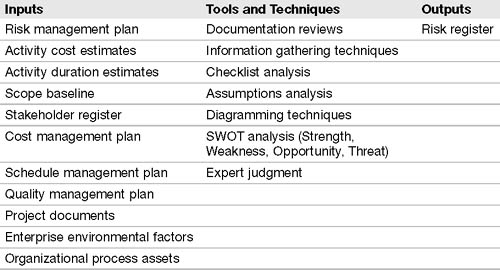
The Risk Register
The risk register is the output of the identify risks process. The risk register contains the following information:
![]() Risk description
Risk description
![]() Date identified
Date identified
![]() Category
Category
![]() Potential responses
Potential responses
![]() Current status
Current status
Qualitative and Quantitative Risk Analysis
Qualitative risk analysis provides further definition to the identified risks in order to determine responses to them. The key terms are probability and impact. Probability is important because it measures how likely a risk will occur. A high-probability risk deserves more attention than a low-probability risk. Likewise, impact is a measure of how the risk will affect the project should it occur. A risk with low impact has a different response than one with a high impact.
Qualitative risk analysis quickly prioritizes risks in order to conduct response planning and quantitative risk analysis, if used. Using the probability of the impact and a probability impact matrix, the project manager develops a prioritized list of risks. The output to this step is captured in the risk register. Table 4.12 shows the inputs, tools and techniques, and outputs for the perform qualitative risk analysis process.
TABLE 4.12 Perform Qualitative Risk Analysis Inputs, Tools and Techniques, and Outputs

Quantitative risk analysis assigns numerical values to risks and looks at those risks that are high on the list of prioritized risks during qualitative risk analysis. The goal of this process is to quantify possible outcomes for the project, determine probabilities of outcomes, further identify high impacting risks, and develop realistic scope, schedule, and cost targets based on risks. Table 4.13 shows the inputs, tools and techniques, and outputs for the perform quantitative risk analysis process.
TABLE 4.13 Perform Quantitative Risk Analysis Inputs, Tools and Techniques, and Outputs

A key tool used in quantitative risk analysis is decision tree analysis. Using a decision tree diagram (see Figure 4.3), the impact of different scenarios is captured. Both probability and cost are used, resulting in an expected monetary value (EMV).
FIGURE 4.3 An example of a decision tree analysis.
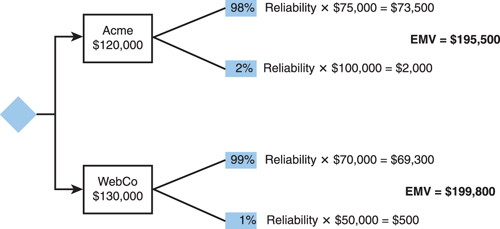
For this example, there are two vendors for a software package; Acme and WebCo. The details of the two options are presented in Table 4.14.
TABLE 4.14 Decision Tree Analysis Example Data

Responses to Positive and Negative Risk
After all risks are identified, options to deal with the risks must be identified. Each risk is assigned to one or more owners to carry out the planned response. The responses are documented in the risk register after it has been updated in the plan risk responses process. Table 4.15 shows the inputs, tools and techniques, and outputs for the plan risk responses process.
TABLE 4.15 Plan Risk Responses Inputs, Tools and Techniques, and Outputs

There are four responses to negative risks:
![]() Avoid
Avoid
![]() Transfer
Transfer
![]() Mitigate
Mitigate
![]() Accept
Accept
For positive risks the responses include
![]() Exploit
Exploit
![]() Share
Share
![]() Enhance
Enhance
![]() Accept
Accept
They are summarized in Table 4.16.
TABLE 4.16 Summary of Risk Responses
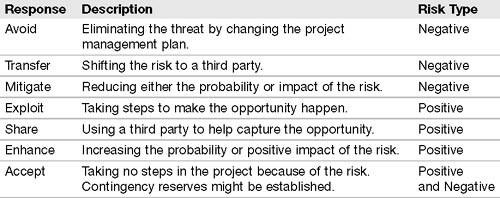
Risk Monitoring and Controlling
The risk process is not just performed once during the planning process. Throughout the project, risks must be continually monitored, with additional analysis and risk response development as new risks are identified. Risk monitoring and controlling focuses both on identification and analysis of new risks, as well as tracking previously identified risks and risk triggers.
Risks should be re-evaluated when the following events occur:
![]() A risk trigger is identified
A risk trigger is identified
![]() A change request is approved
A change request is approved
![]() Key project milestones are reached
Key project milestones are reached
![]() Project phases end
Project phases end
![]() Deviations are detected in variance and trend analysis
Deviations are detected in variance and trend analysis
![]() Corrective or preventive actions are implemented
Corrective or preventive actions are implemented
Cram Quiz
Answer these questions. The answers follow the last question. If you cannot answer these questions correctly, consider reading this section again until you can.
1. Which input is not used for risk identification?
![]() A. Project charter
A. Project charter
![]() B. Scope baseline
B. Scope baseline
![]() C. Cost management plan
C. Cost management plan
![]() D. Academic studies
D. Academic studies
2. In evaluating project risk, a decision tree analysis is most helpful in which of the following scenarios?
![]() A. Describing a potential risk and the implications for each available choice and outcome associated with the risk
A. Describing a potential risk and the implications for each available choice and outcome associated with the risk
![]() B. Describing a potential risk and the most likely choice and outcome associated with the risk
B. Describing a potential risk and the most likely choice and outcome associated with the risk
![]() C. Describing a potential risk and the least likely choice and outcome associated with the risk
C. Describing a potential risk and the least likely choice and outcome associated with the risk
![]() D. None of the above
D. None of the above
3. The identification of risks associated with a project happens when?
![]() A. Occurs only at the beginning of a project when the risk management plan is developed
A. Occurs only at the beginning of a project when the risk management plan is developed
![]() B. Is an ongoing process, regularly scheduled throughout the life cycle of a project
B. Is an ongoing process, regularly scheduled throughout the life cycle of a project
![]() C. Occurs as needed throughout the life cycle of a project
C. Occurs as needed throughout the life cycle of a project
![]() D. Both C and D
D. Both C and D
4. Which of the following is the only valid tool and technique for the plan risk management process?
![]() A. Reserve analysis
A. Reserve analysis
![]() B. Planning meetings and analysis
B. Planning meetings and analysis
![]() C. Expert judgment
C. Expert judgment
![]() D. Contingent response strategies
D. Contingent response strategies
5. Which input is not used for the qualitative risk analysis process?
![]() A. Cost management plan
A. Cost management plan
![]() B. Risk register
B. Risk register
![]() C. Risk management plan
C. Risk management plan
![]() D. Project scope statement
D. Project scope statement
6. Which tool and technique is not used for the Plan Risk Responses process?
![]() A. Strategies for positive risks or opportunities
A. Strategies for positive risks or opportunities
![]() B. Contingent response strategies
B. Contingent response strategies
![]() C. Risk audits
C. Risk audits
![]() D. Expert judgment
D. Expert judgment
Cram Quiz Answers
1. Answer A is correct. The project charter is not used. The scope baseline and cost management plan are used. Academic studies are part of enterprise environmental factors that also include commercial databases, benchmarking, or other industry studies.
2. Answer A is the correct response. A decision tree diagram can be used to consider potential risks and all the implications associated with the risk. You can include every conceivable choice and outcome. Every option is considered. Answer B is incorrect because choice and outcome are limited to the most probable scenario. Answer C is incorrect because choice and outcome are limited to the least probable scenario. Answer D is incorrect.
3. Answer D is the best response. Risk analysis is not limited to the beginning of a project’s life cycle when the risk management plan is developed. The risk management plan should include a tool for risk assessment as a continuous process throughout the project. Risk reassessment should be a scheduled component of the project but should also have the flexibility to occur as needed at greater or lesser intervals based on the level of risk.
4. Answer B is correct. Planning meetings and analysis is the only tool and technique defined for the plan risk management process. All of the other answers refer to tools and techniques from other processes.
5. Answer A is correct. The cost management plan is an input for the perform quantitative risk analysis process. All of the other answers are valid inputs for the perform qualitative risk analysis process.
6. Answer C is correct. Risk audits are a tool and technique for the monitor and control risks process. All other answers are valid tools and techniques for the plan risk response process.
Procurement Management
![]() Plan Procurements—12.1
Plan Procurements—12.1
Procurement management involves the relationship between the buyer and the seller when products, services, or other results are being purchased by the project team in order to complete the project. Key PMI principles for procurement management include
![]() The contract statement of work (SOW) is a key document that defines the work in order to allow buyers the ability to evaluate and bid on the work.
The contract statement of work (SOW) is a key document that defines the work in order to allow buyers the ability to evaluate and bid on the work.
![]() There are three primary contract types:
There are three primary contract types:
![]() Fixed price
Fixed price
![]() Time and material
Time and material
![]() Cost reimbursement
Cost reimbursement
![]() The risk to both the buyer and seller depends on the type of contract chosen.
The risk to both the buyer and seller depends on the type of contract chosen.
![]() The contract is a formal, written document and any changes are submitted in writing.
The contract is a formal, written document and any changes are submitted in writing.
TABLE 4.17 shows the inputs, tools and techniques, and outputs for the plan procurements process.
TABLE 4.17 Plan Procurements Inputs, Tools and Techniques, and Outputs
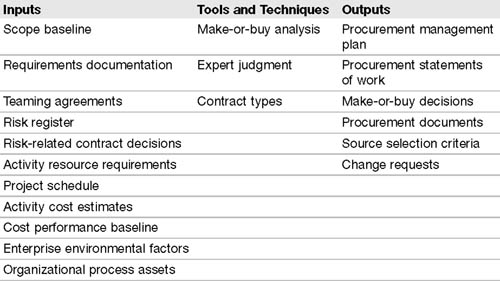
The Make/Buy Decision
The first step in procurement is resolving the make/buy decision. This decision is made during the plan purchases and acquisition process. An analysis is done to determine if the product or service can be produced by the project team or if it should be purchased. This analysis might also include buying versus renting/leasing a product.
The Contract Statement of Work
In addition to making the make/buy decision during the plan purchases and acquisition process, it is during this step that the contract statement of work (SOW) is developed and the type of contract to be used is determined. The SOW is a document that defines the work to be performed. A contract SOW is work performed under contract. The contract SOW is developed from the scope statement and WBS and should be sufficiently detailed to allow the potential sellers to determine their ability to perform the work. A project can have multiple SOWs.
Contract Types
A number of contract types are used in the procurement process. In order to be prepared for the exam, understand the benefit of each type, as summarized in Table 4.18
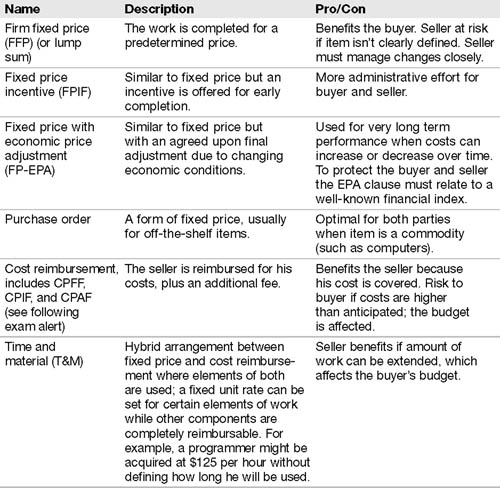
Figure 4.4 illustrates the risk to buyer and seller for the contract types.
FIGURE 4.4 The buyer and seller risk for contract types.
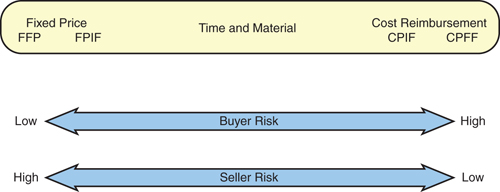
The Procurement Management Plan
The procurement management plan is developed to describe how procurement activities will be carried out. The plan can include content that provides guidance for
![]() Type of contracts to be used
Type of contracts to be used
![]() Risks and risk management issues
Risks and risk management issues
![]() Criteria for independent estimates
Criteria for independent estimates
![]() Standard procurement documents and procedures
Standard procurement documents and procedures
![]() Coordinating procurement with other projects and multiple vendors
Coordinating procurement with other projects and multiple vendors
![]() Project assumptions or constraints that affect procurements
Project assumptions or constraints that affect procurements
![]() Handling procurement schedules
Handling procurement schedules
![]() Addressing make-or-buy decisions
Addressing make-or-buy decisions
![]() Identifying and managing performance requirements
Identifying and managing performance requirements
![]() Identifying prequalified sellers
Identifying prequalified sellers
![]() Procurement metrics used to evaluate sellers and manage contracts
Procurement metrics used to evaluate sellers and manage contracts
Cram Quiz
Answer these questions. The answers follow the last question. If you cannot answer these questions correctly, consider reading this section again until you can.
1. The responsibility for tailoring a contract for goods and services to the needs of the project lies with whom?
![]() A. The project manager
A. The project manager
![]() B. The project management team
B. The project management team
![]() C. The attorneys
C. The attorneys
![]() D. The contract manager
D. The contract manager
2. The decision on whether a product or service can be produced by the project management team or can be purchased is called what?
![]() A. Buyer assessment
A. Buyer assessment
![]() B. Expert judgment
B. Expert judgment
![]() C. Make-or-buy analysis
C. Make-or-buy analysis
![]() D. Procurement evaluation
D. Procurement evaluation
Cram Quiz Answers
1. Answer B is the best response. The responsibility for tailoring a contract for goods and services to the needs of the project lies with the project management team. The project management team can include the project manager, attorneys, and/or contract manager, but the responsibility does not rest solely with one individual.
2. Answer C is the best response. The decision on whether a product or service can be produced by the project management team or can be purchased is called a make-or-buy analysis.
What Next?
If you want more practice on this chapter’s exam topics before you move on, remember that you can access all of the Cram Quiz questions on the CD. You can also create a custom exam by topic with the practice exam software. Note any topic you struggle with and go to that topic’s material in this chapter.
